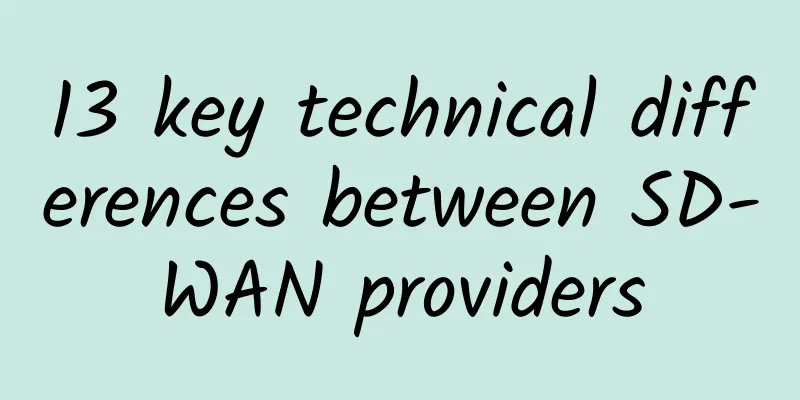13 key technical differences between SD-WAN providers

|
Choosing the right software-defined WAN vendor can seem like a daunting task. There are many vendors to choose from, but each option has its own strengths in terms of technology, market reach, partnerships, and long-term viability.
There are about ten SD-WAN providers on the market, including Aryaka Networks, Cisco Meraki, Cisco Viptela, Citrix, Cradlepoint, Riverbed, Silver Peak, Talari, VMware, and Versa Networks. IT teams can evaluate these providers based on criteria such as the vendor's current SD-WAN technology, future vision, managed service options, and partnerships. How SD-WAN Technology Differs In the competitive SD-WAN market, vendors offer cutting-edge technologies across a range of branch network requirements. Each SD-WAN vendor has specific areas of strength and may have near-term upgrade plans to target specific areas of weakness. This section describes the technical differences between SD-WAN vendors in terms of the capabilities they offer in some key areas of SD-WAN. 1. SaaS-based application optimization As many critical applications migrate to the cloud, a key differentiator for SD-WAN technologies is how they ensure the quality of the remote user experience. SD-WAN providers use a variety of techniques to identify specific applications and provide low-latency services for them. These methods include traffic and application identification, real-time performance metrics, and partnerships with specific cloud and SaaS providers. The SD-WAN management console enables IT to set and change application priorities and monitor performance in real time. Each SD-WAN vendor has a specialized approach to optimizing cloud-based applications. For example, Cisco has partnered with AWS to allow enterprises to seamlessly add AWS resources to their WANs, and Citrix has partnered with Equinix to provide SD-WAN products that can reliably connect enterprise networks to Equinix's more than 140 data centers. Cradlepoint has partnerships with nine of the world's top cloud providers, including AWS, Microsoft Azure, and Rackspace. These partnerships enable Cradlepoint to use network orchestration APIs to automate deployments within data centers. Riverbed's SteelConnect enables real-time, easy configuration of SD-WAN connections in the Microsoft Azure cloud network. This provides one-click connectivity for users accessing Azure applications and data. Silver Peak's EdgeConnect offers First-packet iQ, which identifies applications and web domains based on the first packet received. By applying preset policies, First-packet iQ can automatically direct specific, trusted SaaS traffic directly to the Internet. VMware SD-WAN provides policy-aware traffic optimization, including TCP flow optimization, bandwidth aggregation, jitter buffering, and dynamic multipath optimization. 2. Cybersecurity A long-standing concern for IT departments, remote workers are a significant security vulnerability and challenge. Branch office security requirements can vary widely, depending on the application, vertical industry, and specific regulatory requirements. SD-WAN can be deployed as a security service for the WAN or in conjunction with other network security elements such as firewalls in branch offices, data centers, or clouds. IT teams should judge SD-WAN options based on the overall security provided in the product and the integration capabilities of some security products, such as adding Internet security through a lightweight firewall. For example, Cisco has its own comprehensive network security product line. Cradlepoint works with security vendors including Trend Micro, Webroot and Zscaler. Silver Peak also works with Zscaler, Checkpoint, Fortinet and Palo Alto Networks. VMware works with Palo Alto Networks, Checkpoint, Symantec and Zscaler. 3. Unified Communications IP voice and video traffic requires specific network capabilities, such as low latency and minimal packet loss, to provide a high-quality user experience. SD-WAN allows IT teams to prioritize UC traffic over WAN links, monitor UC traffic performance, and adjust the network to improve network quality. Each SD-WAN vendor has a proprietary application identification and traffic prioritization method to improve UC quality. Some SD-WAN providers have partnerships with specific UC vendors. For example, Citrix SD-WAN allows bonding and packet duplication for real-time traffic and quality of service while selecting the best path. Cradlepoint ensures that real-time applications are always running and on the best performing link by measuring path performance and controlling traffic. Silver Peak makes real-time applications more predictable by reducing packet loss and reordering of out-of-order packets. SD-WAN vendor Talari provides continuous one-way measurement, packet replication, congestion avoidance and bandwidth reservation. Versa has embedded voice and video codec support and provides traffic engineering for unified communications services. VMware accelerates real-time applications by proactively prioritizing traffic while measuring link throughput, packet loss, latency and jitter. 4. WAN Optimization SD-WAN technology overlaps with traditional WAN optimization requirements. WAN optimization is a popular technique used to compress traffic and duplicate packets to improve performance for applications that require large, unencrypted traffic over the wide area network. SD-WAN can be deployed with existing WAN optimization equipment. Alternatively, they can often replace existing WAN optimization equipment. IT organizations with WAN optimization requirements should evaluate the integrated capabilities of SD-WAN products. SD-WAN services from existing WAN optimization vendors, including Citrix, Riverbed, Silver Peak, and Talari, have a relatively mature set of WAN optimization features. Aryaka also offers integrated WAN optimization capabilities through its managed services. 5. Mobile For mobile branch offices and truly mobile remote users, 4G Long Term Evolution (LTE) is the preferred option. Many SD-WAN providers offer 4G LTE via plug-in modems. Cradlepoint is well-positioned to support companies with SD-WAN and 4G LTE needs. 6. Delivery as a Service Many organizations want to outsource the complexity of selecting, deploying, and managing SD-WAN products. Aryaka and Cisco Meraki are well-positioned to outsource technology and services. Many other SD-WAN products can be converted into managed services through service providers, who in turn can use the vendor's technology to support their own services. 7. Service and Support Capabilities SD-WAN is a complex, powerful, and evolving technology. IT organizations may want or need to rely on the vendor or its partners to assist in planning, deploying, operating, and upgrading SD-WAN products. IT teams should evaluate SD-WAN vendors based on their service and support capabilities and the breadth and depth of the vendor's partners, including value-added resellers (VARs), network integrators, system integrators, and service providers to assist with customer or technical issues. Cisco offers a large number of VAR and system integrations, and provides training to customers. Citrix, Cradlepoint, Riverbed, Silver Peak, and Talari also have mature network VAR partner programs. 8. Technical Vision The SD-WAN market is highly competitive and the technology is evolving rapidly. In the long run, SD-WAN products require a high degree of flexibility, agility, and vision. Some key vision areas include:
Aruba, Cisco Meraki, Cradlepoint, Riverbed, and Versa currently have SD-branch products. Other SD-WAN providers plan to add SD-branch capabilities to their products within the next two years. 9. Long-term viability SD-WAN providers range from the largest network providers and mid-sized vendors in adjacent markets to small startups. Most notable are Cisco's acquisition of Viptela and VMware's acquisition of VeloCloud. Doyle Research expects significant market restructuring in the next three to five years. Despite rapid revenue growth, the market clearly will not support the current crop of 40-plus SD-WAN technology providers. IT organizations evaluating SD-WAN platforms should carefully examine the mid-term viability of potential vendors. 10. Purchase by subscription IT organizations are shifting from buying products to buying subscriptions. The benefits of subscription buying networks are simple purchase and deployment, and automatic software upgrades to the latest features. Some vendors offer SD-WAN services via subscription. For example, Aryaka prices by location and bandwidth. Cisco Meraki offers SD-WAN and other network features via subscription. Citrix allows customers to purchase NetScaler SD-WAN appliances at zero capacity and then periodically certify the software at specific capacity levels. Cradlepoint's NetCloud Solutions bundles hardware, software and services. Users get ongoing software updates and 24/7 support for one, three or five years. Riverbed offers SD-WAN software on a monthly subscription basis with bandwidth capacity. Talari offers SD-WAN subscriptions through its partners for three years, priced by bandwidth requirements. 11. Hosting Service Options Many service providers offer the option of outsourcing SD-WAN technology by delivering it as a managed service. IT organizations should consider the benefits of purchasing a managed SD-WAN offering. After evaluating SD-WAN requirements, IT leaders can choose the best SD-WAN technology with a managed services partner or rely on the service provider to select the right technology. SD-WAN vendors should have a range of partners and then sell managed service products to them. Customers can choose between communications service providers and managed service providers. 12. Communications Service Provider (CSP) Companies such as AT&T, CenturyLink, Comcast, and Verizon offer SD-WAN as a managed service that is bundled with transport services, which include MPLS, Ethernet, Internet, and 4G LTE. These bundles represent a one-stop shop that enables existing customers to easily migrate to SD-WAN. 13. Managed Service Provider (MSP) Companies such as IBM and Hughes Network Systems provide WAN operations outsourcing services to many IT organizations. MSPs do not own their own networks, but instead contract with existing CSPs and SD-WAN vendors to provide a fully managed service. For example, Cisco is working with British Telecom and Verizon. Silver Peak is working with China Telecom, Fujitsu, Masergy, and NTT. Versa's partners include CenturyLink, China Telecom, Comcast, Singtel, and Verizon. VMware is working with AT&T, Sprint, and Windstream. Evaluating and selecting SD-WAN products is challenging due to the complexity and power of the technology and the breadth of vendor choices. IT professionals should carefully evaluate current branch WAN requirements, applications, and recent developments to prioritize the key features needed in an SD-WAN vendor platform. SD-WAN technology should be easy to integrate into existing IT network infrastructure, and SD-WAN providers with a broad ecosystem have an advantage here. |
<<: The second decade of cloud computing: How will the three major operators welcome it?
>>: Is 5G not the only option for the Internet of Things?
Recommend
Discussion on performance optimization technology of gateway current limiting function
With the popularity of microservice architecture ...
RackNerd: Multi-room AMD Ryzen+DDR4+NVMe series VPS is available for purchase starting at $14.18 per year
RackNerd is a foreign hosting company founded in ...
Wireless technology is gradually becoming an important direction for network development and application in the future industrial Internet
Germany's "Industry 4.0 R&D White Pa...
Hosteons France/Germany data centers are online, $17.99/year-1GB/20G NVMe/2TB@10Gbps
Hosteons announced the launch of VPS in French (P...
When will the price of NB-IoT modules drop below 20 yuan?
The cost of NB-IoT, especially the module cost, h...
5G will become a new engine of economic growth
my country's 5G network construction and appl...
Expert: It is impossible for the United States to bypass 5G and develop 6G
On September 21, at the opening event of Sina 5G ...
H3C SD-WAN security solution builds an integrated security assurance system for enterprise WAN
On September 26-27, the "2022 China Cloud Ne...
2021 Apps UP Competition | Huawei Chen Lifang: The stars will never fade, let’s walk hand in hand
[Beijing, June 10] The 2021 Huawei HMS Global App...
Five technical challenges in deploying IoT networks
Network architects and system engineers beware—ge...
In the 5G era, limited spectrum is used in a variety of ways
A spectrum comparable to gold Wireless spectrum i...
Share | Basic knowledge of 5G wireless network
Wireless networks have improved dramatically over...
The invisible shift of HCI
Arthur C. Clarke, a famous British science fictio...
The fourth largest operator enters the market, and the 5G market welcomes a new growth point
It has been three years since my country issued f...
Site24x7 enters China's cloud monitoring market and opens Shanghai data center
On March 12, 2019, Zoho Corporation announced the...









